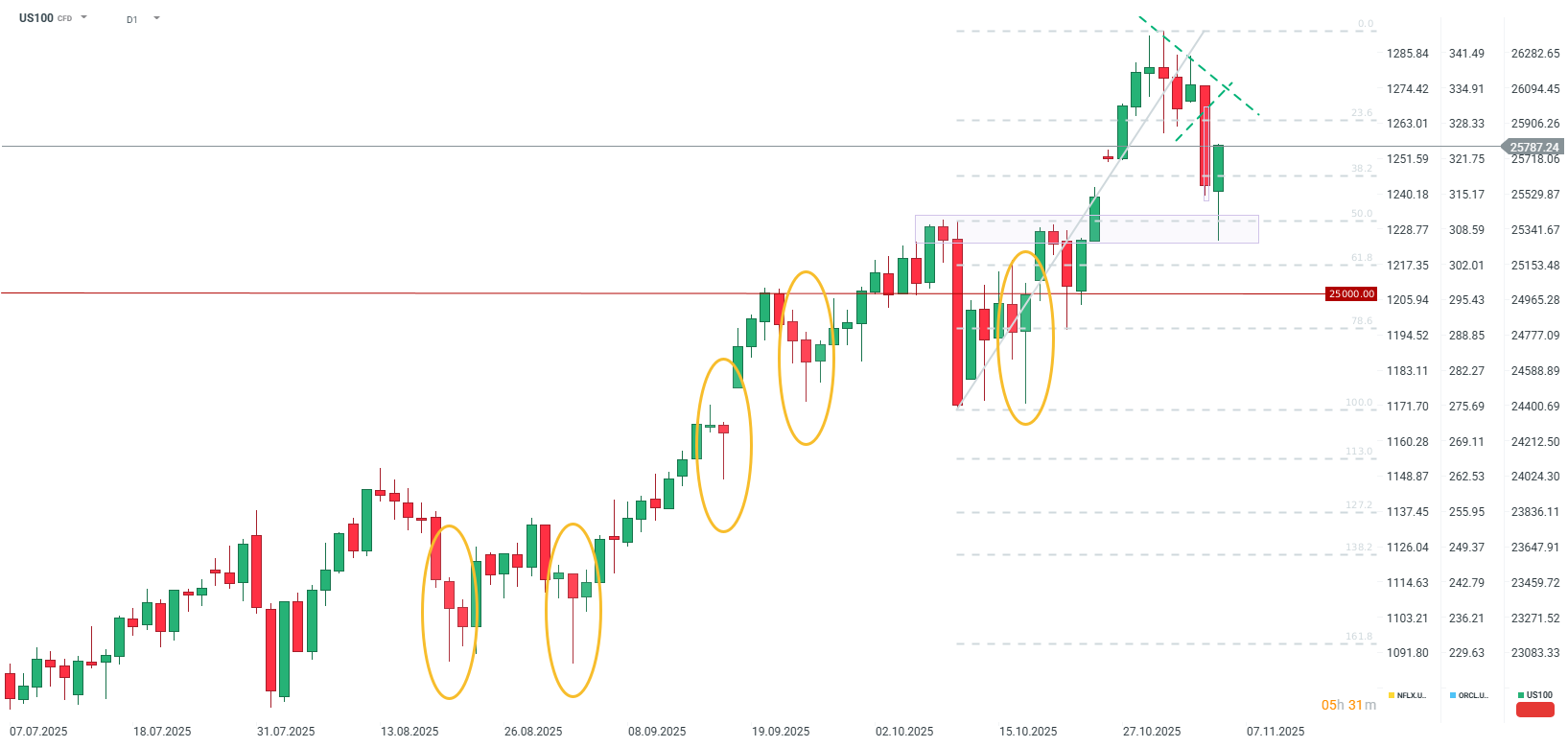-
Tariff Relief Hope: Nasdaq leads gains as the Supreme Court shows skepticism toward Trump's tariff authority, signaling a potential reduction in trade risk and inflation fears.
-
Technical Rebound Confirmed: Strong demand at the 50% Fibonacci retracement confirms the end of the recent correction and sustained bullish momentum for US indices.
-
Inflation Outlook Improved: A ruling against the tariffs could lower costs for businesses and allow the Fed to consider faster and deeper rate cuts in the future.
-
Tariff Relief Hope: Nasdaq leads gains as the Supreme Court shows skepticism toward Trump's tariff authority, signaling a potential reduction in trade risk and inflation fears.
-
Technical Rebound Confirmed: Strong demand at the 50% Fibonacci retracement confirms the end of the recent correction and sustained bullish momentum for US indices.
-
Inflation Outlook Improved: A ruling against the tariffs could lower costs for businesses and allow the Fed to consider faster and deeper rate cuts in the future.
Recent hearings at the U.S. Supreme Court concerning the tariff dispute introduced by the Trump administration could have a significant impact on financial markets and the ongoing dynamics of the Wall Street recovery. The core issue before the court involves the legality of imposing tariffs on select countries under the International Emergency Economic Powers Act (IEEPA).The Court has demonstrated clear skepticism regarding the President’s authority to apply tariffs this broadly, suggesting that a potential limitation on this practice is likely.
Positive Implications for Markets and Inflation
For equity investors, potential restrictions on tariffs are crucial as they could:
-
Reduce Trade Tensions and Volatility: This would mitigate the risk associated with trade wars, which have been a significant driver of uncertainty and volatility in markets for several quarters. Limiting trade policy uncertainty could thus favor stabilization and eventual growth across indices, including the S&P 500 and Nasdaq.
-
Ease Inflationary Pressure: A reversal to the pre-tariff status quo could help dampen domestic inflation, which might prompt the Federal Reserve to implement quicker and deeper rate cuts next year.
-
Boost Corporate Margins: Reduced tariffs would lower costs for importing businesses, positively impacting their margins and overall earnings outlook. This improves investor sentiment, favoring increased buying activity in the stock market.
Technical Strength and Outlook
Although a final ruling from the Supreme Court is not expected until next year, the mere prospect of a trade policy slowdown is already perceived as a potential catalyst for Wall Street. Investors are closely monitoring the proceedings as they signal a reduction in geopolitical and trade risk, supporting more stable market growth.
The Nasdaq 100 (US100) is gaining nearly 1% from the market open (and nearly 2% from its intraday low). Technically, the market is showing a strong demand reaction at the 50.0% Fibonacci retracement of the last major uptrend. Should today’s candlestick close with a large body and a significant lower wick, it would, from a technical perspective, suggest a possible longer-term rebound, based on analysis of similar candles in recent months. The next target for buyers is to surpass the 26,000 point level.

While declaring Trump's tariffs illegal could lead to their re-imposition via other channels, the immediate market positivity is driven by the expectation of an illegality ruling. Conversely, commentary from Trump regarding the case may still pose a risk to indices.
Macro Focus: A Fiscal Turning Point in the United Kingdom?
How will another German pivot end?
DE40: European tech and defence stocks sell-off
BREAKING: FOMC minutes - many against December cut!
The content of this report has been created by XTB S.A., with its registered office in Warsaw, at Prosta 67, 00-838 Warsaw, Poland, (KRS number 0000217580) and supervised by Polish Supervision Authority ( No. DDM-M-4021-57-1/2005). This material is a marketing communication within the meaning of Art. 24 (3) of Directive 2014/65/EU of the European Parliament and of the Council of 15 May 2014 on markets in financial instruments and amending Directive 2002/92/EC and Directive 2011/61/EU (MiFID II). Marketing communication is not an investment recommendation or information recommending or suggesting an investment strategy within the meaning of Regulation (EU) No 596/2014 of the European Parliament and of the Council of 16 April 2014 on market abuse (market abuse regulation) and repealing Directive 2003/6/EC of the European Parliament and of the Council and Commission Directives 2003/124/EC, 2003/125/EC and 2004/72/EC and Commission Delegated Regulation (EU) 2016/958 of 9 March 2016 supplementing Regulation (EU) No 596/2014 of the European Parliament and of the Council with regard to regulatory technical standards for the technical arrangements for objective presentation of investment recommendations or other information recommending or suggesting an investment strategy and for disclosure of particular interests or indications of conflicts of interest or any other advice, including in the area of investment advisory, within the meaning of the Trading in Financial Instruments Act of 29 July 2005 (i.e. Journal of Laws 2019, item 875, as amended). The marketing communication is prepared with the highest diligence, objectivity, presents the facts known to the author on the date of preparation and is devoid of any evaluation elements. The marketing communication is prepared without considering the client’s needs, his individual financial situation and does not present any investment strategy in any way. The marketing communication does not constitute an offer of sale, offering, subscription, invitation to purchase, advertisement or promotion of any financial instruments. XTB S.A. is not liable for any client’s actions or omissions, in particular for the acquisition or disposal of financial instruments, undertaken on the basis of the information contained in this marketing communication. In the event that the marketing communication contains any information about any results regarding the financial instruments indicated therein, these do not constitute any guarantee or forecast regarding the future results.


